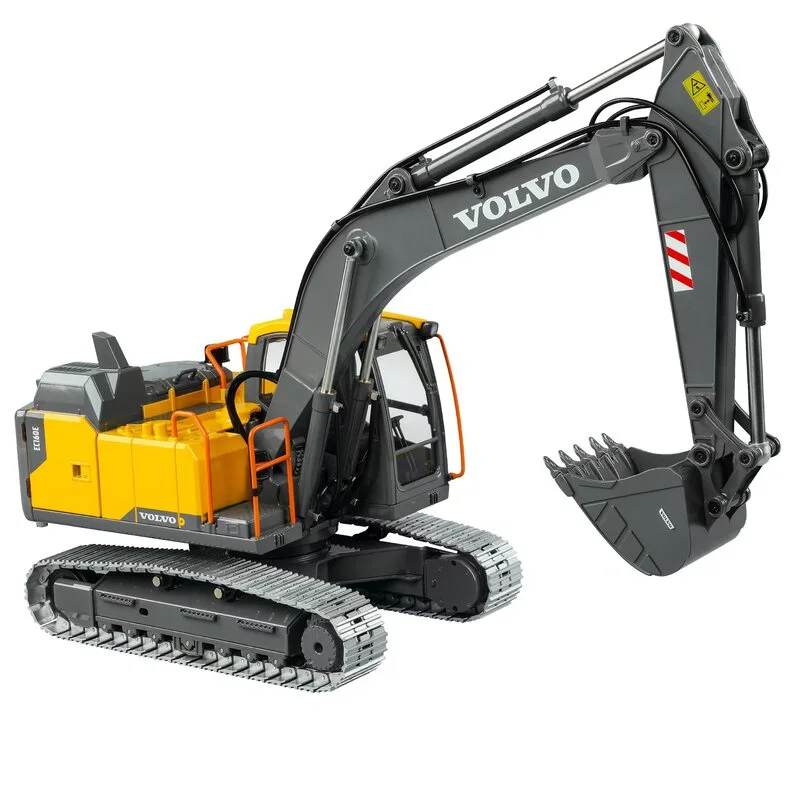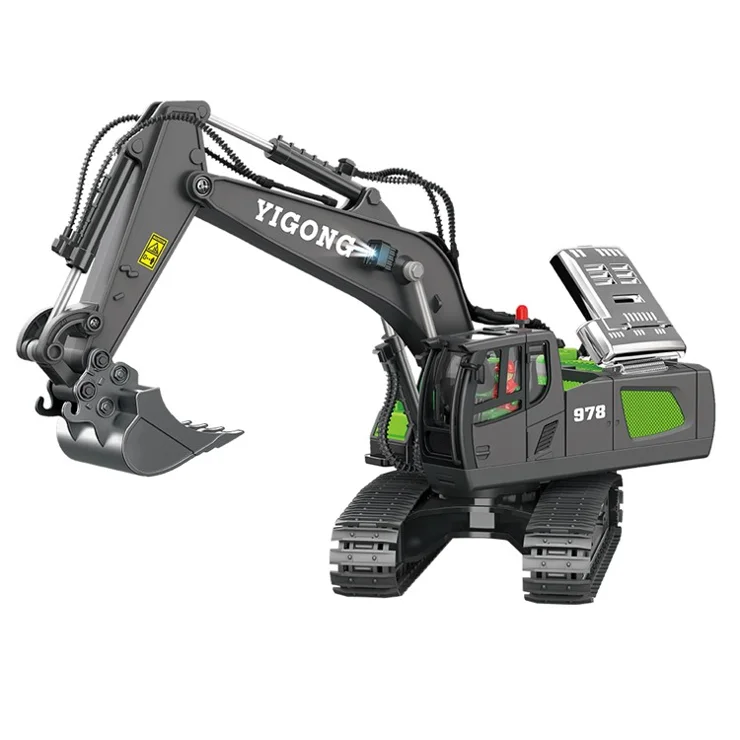The Vital Attributes of Excavator That Make It a Must-Have Device
Excavators are indispensable in the building and construction and landscaping markets. Their versatile add-ons enable for a variety of jobs, from excavating to demolition. Furthermore, they boast superior excavating depth and reach, powered by durable engines. Driver convenience and portable styles enhance use in different atmospheres. What really sets excavators apart are their advanced hydraulic systems and longevity. Comprehending these attributes can clarify why they are considered necessary devices on any type of task website.
Flexible Add-ons for Boosted Capability
Although excavators are powerful devices on their own, the addition of functional add-ons significantly improves their performance. These accessories transform a common excavator right into a multi-purpose device, suitable for a selection of jobs. Pails, for instance, come in various sizes and shapes, allowing drivers to dig, scoop, and move materials effectively. Hydraulic thumbs can be included for improved gripping and handling of cumbersome things, such as logs or rocks.Furthermore, specialized add-ons like breakers and augers allow for exploration and demolition job, expanding the excavator's utility on building sites. remote control excavator. Grapples are one more alternative, perfect for relocating and sorting debris. This flexibility not just boosts productivity but likewise decreases the requirement for numerous machines, saving time and expenses. By equipping excavators with the appropriate add-ons, drivers can tackle varied tasks, making them indispensable in the building and construction market
Superior Excavating Depth and Reach
Excavators are designed with remarkable digging depth and reach, permitting them to steer in limited rooms and access hard-to-reach areas. This capacity is crucial for numerous building and excavation tasks, where traditional equipment may drop short. With flexible boom arms and extendable tracks, excavators can quickly navigate irregular terrain while keeping stability.The excavating deepness can differ significantly amongst models, commonly varying from 10 to 25 feet, relying on the style and function. This feature allows drivers to dig deep into structures, trenches, and other deep structures effectively. Furthermore, the reach of an excavator permits exact digging and material handling without rearranging the machine frequently, saving time and labor costs.Ultimately, the premium excavating deepness and reach of excavators make them crucial for experts seeking to complete complicated jobs with precision and performance. Their adaptability enhances productivity on work websites, showcasing them as a crucial tool in modern construction.
Powerful Engine Performance

Effective engine efficiency plays a crucial function in the capacities of an excavator when it comes to effectiveness and productivity on construction sites. A robust engine generates substantial horsepower, allowing the device to deal with heavy-duty jobs with simplicity - remote control excavator. This strength converts right into faster cycle times, enabling drivers to complete jobs a lot more quickly.Additionally, powerful engines give the needed torque to manage challenging surfaces and varied lots, ensuring that the excavator can carry out efficiently under various problems. Whether it is lifting, excavating, or moving products, the engine's efficiency straight influences the total functional performance of the machine.Furthermore, advancements in engine modern technology have actually led to improved fuel performance, decreasing functional costs while preserving power output. Ultimately, the engine's efficiency works as the foundation of an excavator, affirming its status as a crucial device in the building industry
Advanced Hydraulic Equipments

Improved Lifting Ability
A substantial enhancement in raising capability can be associated to sophisticated hydraulic systems found in modern excavators. These systems use high-pressure fluid to generate greater force, permitting drivers to raise larger loads easily. The design behind these hydraulics guarantees peak performance, supplying an impressive power-to-weight ratio that boosts general performance. Therefore, excavators can deal with requiring jobs, such as raising large products or devices, without jeopardizing security. Additionally, the robust design of hydraulic parts adds to raised durability and integrity, making them ideal for numerous building settings. This enhanced training capacity not only reduces the moment needed for jobs yet additionally minimizes the requirement for added machinery, verifying crucial for both efficiency and cost-effectiveness in the construction industry.
Enhanced Accuracy Control
Although traditional excavators typically struggled with precision, modern hydraulic systems have actually transformed control mechanisms, allowing operators to implement jobs with exceptional precision. These innovative systems use proportional control shutoffs that allow for smoother and extra receptive movements, significantly minimizing the margin for mistake. Operators can now finely tune the excavator's movements, making it much easier to browse limited spaces and deal with fragile products. Boosted responses systems better inform operators of real-time efficiency, making certain perfect control between the maker and driver. This enhanced accuracy not just improves efficiency but additionally boosts safety on work sites, decreasing the risk of accidents. Therefore, modern-day excavators outfitted with innovative hydraulic systems are very useful tools for construction and excavation learn the facts here now jobs needing careful accuracy.
Driver Comfort and Visibility
Driver convenience and exposure are important elements in the layout of modern-day excavators (remote control excavator). Attributes such as ergonomic seat style, improved presence choices, and effective control designs significantly improve the driver's experience and efficiency. Prioritizing these facets warranties that drivers can work efficiently and securely in various conditions
Ergonomic Seat Style
Comfort and visibility are critical in excavator layout, with the ergonomic seat playing a necessary role in improving the driver's experience. An ergonomic seat is crafted to sustain the operator's body, decreasing exhaustion throughout long hours of operation. Flexible attributes, such as seat height, backrest angle, and lumbar support, satisfy specific preferences and promote optimal stance. These changes enhance comfort and allow the driver to keep focus on jobs without discomfort. Additionally, a properly designed seat can offer much better side assistance, enabling smoother maneuvering when the excavator is in operation. This thoughtful design not only boosts efficiency however likewise contributes to total security, making sure that operators can perform their obligations successfully and successfully.
Improved Visibility Features
The style of an excavator prolongs past simply the seat, with enhanced presence features playing a considerable duty in driver convenience and overall security. Large windows and purposefully positioned mirrors provide operators with a clear sight of their surroundings, decreasing dead spots. This design factor to consider permits much better spatial awareness, which is crucial in hectic job settings. Additionally, many excavators include rearview cameras and advanced monitoring systems that help drivers in maneuvering tight areas. The combination of these exposure features not only promotes security yet also lowers operator exhaustion by making it possible for simpler monitoring of work areas. Eventually, enhanced exposure contributes to extra effective procedures and aids assure that excavators can do their tasks efficiently and securely.
Control Layout Performance
While handling complex work websites, a reliable control design significantly enhances both driver comfort and exposure. A properly designed control setup assurances that operators can access crucial features with marginal effort, reducing exhaustion during lengthy hours. Ergonomic joystick placements and Discover More intuitive switch arrangements permit smooth procedure, allowing operators to preserve concentrate on the task at hand. Additionally, clear exposure of both the workplace and the control board is important for safety and precision. Modern excavators commonly integrate flexible seating and control setups to accommodate numerous driver preferences, even more improving comfort. Ultimately, an attentively developed control design not just enhances performance but likewise cultivates a much safer working setting by allowing drivers to respond swiftly to altering conditions.
Compact Design for Urban Environments
As city construction websites often face area constraints, a small layout becomes crucial for excavators operating in these atmospheres. These equipments are engineered to navigate tight areas, enabling reliable ability to move in crowded task sites. A lowered footprint enables them to function carefully to existing frameworks, lessening disruption and taking full advantage of productivity.The small layout commonly includes much shorter tracks and a tighter transforming span, facilitating operation in slim streets and restricted areas. Moreover, light-weight products add to reduce of transportation, making it less complex to relocate the excavator from one place to one more within the urban landscape.Additionally, several compact excavators are equipped with attributes such as extendable arms and versatile attachments, enhancing their performance while preserving a small dimension. This adaptability permits drivers to deal with a variety of jobs, from Get More Info digging to demolition, all while suitable perfectly right into the constraints of metropolitan atmospheres.

Durability and Maintenance Considerations
Durability stands as an important consider the efficiency and long life of excavators, specifically popular city atmospheres. These equipments are subjected to rigorous problems, including varying soil types, severe temperatures, and high-frequency use. Top quality materials and durable construction are needed for making sure that excavators can stand up to these challenges without jeopardizing functionality.Regular maintenance is just as essential in maintaining toughness. Scheduled examinations, timely oil adjustments, and the replacement of used elements add significantly to an excavator's lifespan. Operators needs to additionally take note of hydraulic systems, tracks, and undercarriages, as these parts often birth the force of wear and tear.Investing in sturdy excavators with comprehensive upkeep strategies enhances dependability and minimizes downtime, ultimately causing enhanced performance on building sites. Understanding the interplay between resilience and upkeep is necessary for anyone thinking about the procurement of an excavator for metropolitan projects.
Often Asked Concerns
How Do Excavators Compare to Other Construction Devices?
Excavators stand apart among building devices because of their convenience, allowing tasks such as lifting, grading, and excavating. Compared to others, their hydraulic capacities offer greater performance and power, making them crucial on numerous work sites.
What Security Includes Are Included in Modern Excavators?
Modern excavators incorporate various safety features, including rollover protection systems, alarms, and progressed exposure enhancements. These elements function with each other to lessen dangers, ensuring operator security while improving performance on building and construction websites and various other requiring settings.

Can Excavators Be Made Use Of in Winter Season Conditions?
Excavators can certainly be used in winter months conditions, provided they are geared up with suitable wintertime add-ons and preventative measures are taken. Proper maintenance and modifications boost their performance, guaranteeing effective operation despite tough climate circumstances.
What Is the Typical Life Expectancy of an Excavator?
The typical life-span of an excavator generally varies from 7,000 to 10,000 hours of operation. This period can greatly rely on upkeep methods, running conditions, and the particular design's durability and style features.
Just how Do I Choose the Right Excavator Size for My Job?
Choosing the appropriate excavator dimension involves reviewing job range, site conditions, and material kinds. Think about factors like reach, deepness requirements, and weight capability to assure optimal efficiency and security during operation. Dimension matters significantly in job success. In addition, the reach of an excavator permits for specific digging and material handling without rearranging the machine regularly, conserving time and labor costs.Ultimately, the premium excavating deepness and reach of excavators make them essential for experts looking for to finish complex jobs with precision and performance. Convenience and visibility are paramount in excavator layout, with the ergonomic seat playing an important role in boosting the driver's experience. The style of an excavator prolongs beyond just the seat, with enhanced exposure features playing a considerable duty in operator comfort and general safety and security. Modern excavators typically integrate flexible seats and control settings to accommodate different operator preferences, additionally improving convenience. Lightweight products contribute to relieve of transportation, making it easier to relocate the excavator from one place to another within the urban landscape.Additionally, numerous portable excavators are equipped with features such as flexible add-ons and extendable arms, boosting their performance while preserving a tiny dimension.
Comments on “10 Common Mistakes to Avoid When Operating a rc excavator”